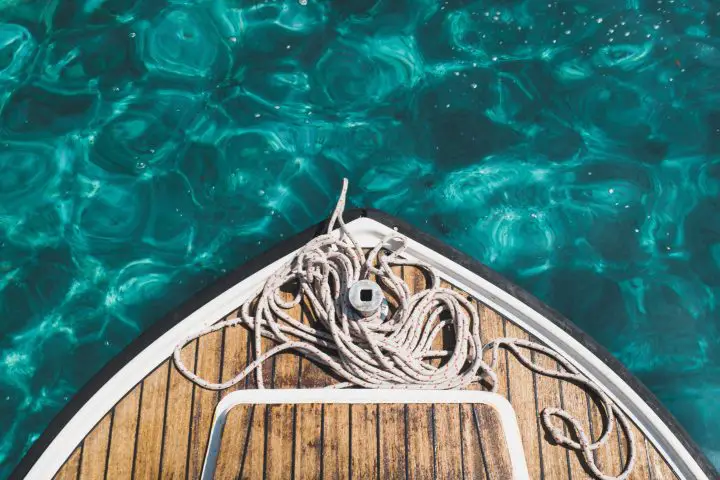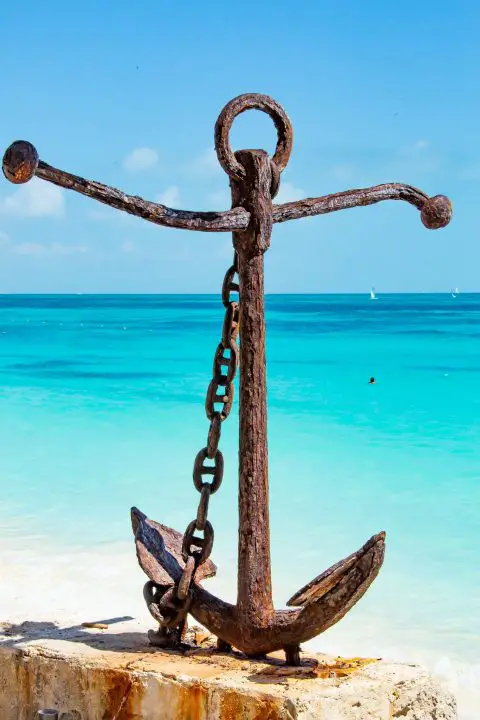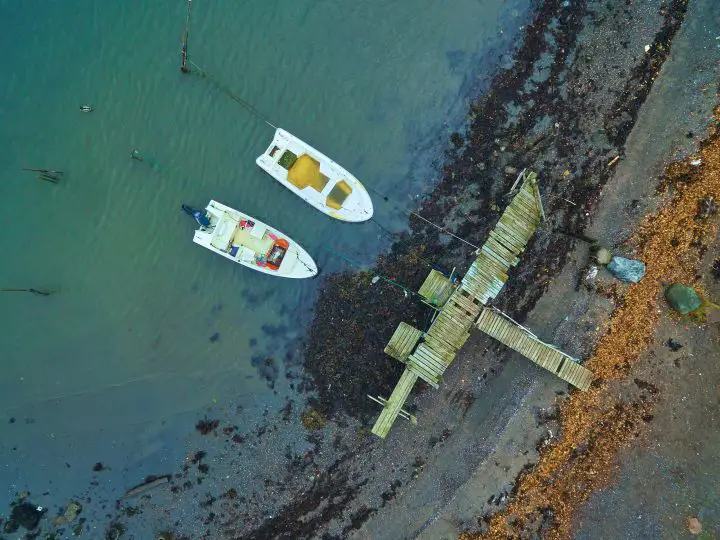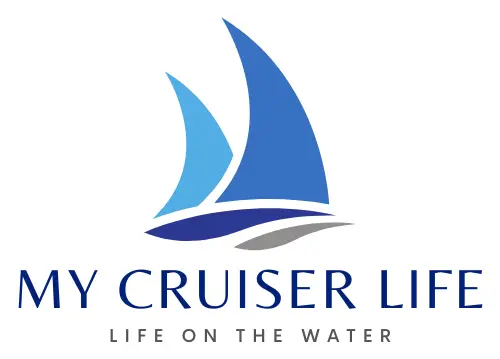Having more than one anchor onboard is good seamanship. Most of the time, cruising boats can simply set their primary anchor from the bow and celebrate with an anchor’s down beverage. But there are some occasions when a secondary or stern anchor becomes necessary to get a good night’s sleep. While setting a stern anchor is an extra step, there are many times when there is no substitute for a second anchor, no matter how modern and trustworthy your primary one is.
Table of Contents
- Why Carry Two Anchors?
- Why Set a Bow and Stern Anchor?
- Bow to Stern Anchor vs Bahamian Moorings
- How to Anchor From the Stern
- Tips for Stern Anchoring
- Celebrate Your Anchoring Success
- Stern Anchor FAQs

Why Carry Two Anchors?
It’s always a good idea to carry more than one anchor. If nothing else, you should have a backup. Most long-range cruisers like to have at least three aboard–an oversized anchor for storms, an everyday primary anchor, and a smaller secondary or stern anchor.
But a secondary anchor is handy for a lot of things. Many people keep this anchor mounted on their stern, hence the name. But the secondary anchor can be carried anywhere and can serve any purpose you need it to at the time.
If there are any rules regarding your secondary, they are that it should be smaller and easier to manage than your primary, and a different type of anchor than your primary. If you find yourself in challenging anchoring conditions where you cannot get your primary to set, having another style of anchor onboard could come in handy.
Some sailors may have a primary and secondary on their bow in addition to a stern anchor. If you have the space and weight capacity to dedicate, this will give you a lot of options. Plus it will mean you won’t be lugging that stern anchor around to get it where you need it. In the end, every boat is set up as her skipper wants her. Put your secondary where you think you’ll need it most often–but don’t be afraid to move it around.
Uses for Your Primary Anchor
- Normal, everyday anchoring in most condtions
- Since it’s used everyday it is usually your nicest anchor and attached to your nicest anchor lines
- Usually set up to the boat’s primary windlass and ready to deploy at all times from the bow
- Sized for calm conditions through storm conditions, although some serious cruisers carry another much larger storm anchor for heavy weather
- Can be used in concert with your primary to set up a Bahamian mooring (two anchors set off the bow) or a bow and stern anchoring for no swinging
Uses for a Secondary Anchor
- Anchoring bow and stern to prevent swinging at anchor in narrow channels or tidal rivers
- Counter uncomfortable swell conditions
- Use as an emergency anchor, such as kedging off after a grounding
- Set a stern hook when the bow is tied to shore, as in a Mediterranian mooring
- Move to the bow to set up a Bahamian mooring
- Use as a kellet weight on the primary rode to reduce scope

Why Set a Bow and Stern Anchor?
Cruisers can usually successfully anchor by heading into the wind and deploying their anchor from the bow. However, there are a few conditions where a stern anchor is necessary. If you are anchored into the wind, but affected by a swell, you might want to set a stern anchor for a more comfortable stay. If you are in a tight anchorage, a narrow channel, or anchored too close to land, a stern anchor can help you stay exactly where you want to be without swinging.
Uncomfortable Conditions Caused by Swell
There are many beautiful bays around the world that offer protection from prevailing winds. Often, cruisers enter these anchorages, set the anchor, and start reaching for their anchors-down libation. It’s usually about now, or, when these nice cruisers are headed for a nice night of restful sleep that the dreaded wrap-around swell starts to affect their otherwise well-anchored boat. What is this wrap-around swell nonsense? What is a cruiser to do?
Wrap-around swell happens when ocean swell arrives at your bay, and instead of stopping or disappearing, sneakily enters the anchorage. If the swell is oriented with the wind, you’ll probably be comfortable. However, sometimes the swell slaps against the beam. This can be noisy and uncomfortable.
Narrow Channels
If you’re anchored in a small area next to a narrow channel, you will probably want to stay out of the channel. If you don’t have to space to swing 360 degrees, setting a stern anchor can help you stay out of the channel. Likewise, if you’re anchored within swinging distance of land, a stern anchor can keep you in position.
Emergency Situation
You never know when an emergency might happen, so it’s best to be prepared. While some small boat operators can get away with just one anchor onboard, it’s best to have a secondary anchor that acts as a rear anchor for boat emergencies. The great thing about mounting a small anchor on your stern rail is that it’s always ready to go and easy to grab.
You might use a stern anchor for kedging yourself off a sandbar or a reef. If you have an engine failure in a tight channel, you can set both your primary and your stern anchor while you troubleshoot.

Bow to Stern Anchor vs Bahamian Moorings
When putting down two anchors, there is some confusion between the concept of putting one off the bow and one off the stern, and the purpose of the very different Bahamian Mooring. As discussed above, putting one anchor off each end of the boat keeps the boat in place with no swing. The bow will not come around and point into the wind and current. If the wind hits the side of the boat, the boat will move sideways until the anchor lines stop it. Unfortunately, this puts a lot of force on your anchors and not in the correct way. In extreme cases, they may drag.
A Bahamian Mooring is different because both anchors are set from the bow. This means that the boat will still point into the wind or current. This is important because it means that the boat will pull straight back on the anchor–the way that provides the best holding from your anchor.
Bahamian Moorings get their name from their wide use in the Bahamas, where there are skinny creeks with strong tidal currents. If you just set one anchor, you would likely find yourself running around on the edges of the channel when the tides switched directions. Having another anchor set in the opposite direction means the boat will stay in the middle of the channel.
To set a Bahamian Mooring, you put each anchor in the direction of the strongest forces on the boat. Tidal creeks are just one place they come in handy. They’re also great when you’re expecting a big blow to come through. Look at the forecast and figure out where the worst winds will be. For example, many cold fronts in the southeastern US start with strong southwesterlies followed by even stronger northerlies. So, you might set your primary to ride the north winds, and your secondary to ride the southwest winds.
The advantage of this setup is that you can set each anchor before the winds arrive. As you ride out the storm, there will be no doubt whether or not the anchor will set with the shifting wind directions because you already set it and made sure it would hold.
How to Anchor From the Stern
Another option, although not as secure, is to set your primary anchor from the bow and your secondary from the stern. Then, the boat will not swing at all and will not point into the wind or current. So, it’s up to the skipper to make sure that the boat is aligned with the strongest forces when setting the hooks. It’s best if you point your bow into the strongest expected force, usually the ebb tide on rivers.
First, you’ll want to determine how much rode each anchor needs. This should be a scope of five to seven times the water’s depth, although you might opt for more if you are using nylon rodes or stronger conditions are expected.
Drop your primary anchor and set it into the direction of the strongest forecasted conditions. Let out double the scope you need. Now, you should be roughly in the position where you want to drop the second stern anchor. Drop it from the stern, and then pull forward a bit on your primary rode to set the stern hook.
You could also drop and set the stern anchor from your dinghy. Once the primary is set with the appropriate amount of rode out, a crew member can dinghy the stern anchor into position. The cruising boat should align the boat with the waves, while not disturbing the primary anchor.
When the cruising boat is lined up, the dinghy crew can drop the stern anchor. The cruising boat will slowly pull forward against the stern anchor to set it. Anchoring from the stern might take a few tries, but it’s worth it to be comfortable on board in those really tight spots.
If you are expecting a strong blow and shifting winds, choosing a Bahamian Mooring is a better choice. Unless all of the strong winds and currents are aligned with the boat’s bow, anchoring fore-to-aft as described above my place unreasonable loads and forces on your anchors.
How Much Anchor Rode Does a Stern Anchor Need?
If you are using a stern anchor to solve uncomfortable conditions, you should set out five to seven times the water’s depth. Storm conditions might warrant as much as ten times, although in severe weather it’s advisable not to use a stern-mounted anchor. Remember to calculate the water depth at high tide and add the distance from the water to your stern cleat.
Retrieve the Stern Anchor
Picking up a stern anchor is basically a repeat of the setting process. You can let out your primary rode and let the boat drift back until you’re over the stern anchor, retrieving the line along the way. Once the stern anchor is aboard, recover your primary as usual.
Another way to get the stern anchor back is to send the dinghy crew back out. Hopefully, they can easily pull the stern anchor up. If it has been set well, it might be a bit of a struggle.
Med Mooring
If you plan on sailing in the Mediterranean, you’ll want to practice perfecting a med moor. This is a docking setup where the bow or stern of the boat is next to a quay wall, and the boat is held off only by its anchor. Generally you put the part of the boat that is easiest to get on and off of to the quay wall–and that’s usually the stern.
Many sailboats, however, are notoriously difficult to maneuver in reverse. Plus, some boats are fairly easily to get on and off of from the bow–so there are times when going in bow-to the quay and setting a stern anchor will make sense.
To use a bow-to Med mooring, you’ll drop the stern anchor as you motor towards the pier. The crew on the bow are responsible for tying up with bowlines on shore, while the crew at the stern properly tie off and set the stern anchor. Like all stern anchoring techniques, this will take some practice.

Tips for Stern Anchoring
Use a Trip Line and Buoy
You might want to use a trip line and marker buoy on your secondary anchor. Using a trip line can help you retrieve your anchor. Instead of pulling on the secondary anchor, you can give the trip line a good yank, dislodge the anchor easily, and then raise it. If you’re working from a dinghy, this is very helpful.
The buoy also marks the spot of your secondary anchor. This can be helpful when you are ready to retrieve it, and it lets other boaters know you have a stern anchor set. However, it can also be a nuisance. If you are in a busy anchorage with small boat traffic, your trip line and buoy might trip another boat up.
Have a Stern Anchor System
Different cruisers use different systems to manage their stern anchor. A stern anchor can be handy in an emergency. If you frequently use your stern anchor, or want it ready for an emergency, consider mounting it to your stern rail. Some cruisers set up a system to manage the stern anchor and rode. Alternatively, you can have the stern anchor mounted on the stern rail and store the rode in a cockpit locker. You’ll simply have to attach the anchor to its rode and you’ll be ready to go.
One nice system is the anchor rode reel, which supports a nylon webbing rode that mounts right on the stern rail. These are more common in parts of the world where stern anchoring is very common, like Northern Europe. The Ultraline Flat Rope Reel is a great example.
Find the Best Stern Anchor
Most boaters just use the secondary anchor their boat came with! Or, if you upgrade your primary anchor you may keep the old one as your new secondary.
Many boats use a fluke-style anchor, like a Danforth or a Fortress, as their secondary anchor. Some boats have a combination of chain and rode (rope), and some use 100% nylon to save weight and space. Since stern anchor operations often involve managing the anchor and rode in a dinghy, you don’t want to make your secondary set-up too heavy or cumbersome.
- The Fortress Anchor Advantage: A hardened High-Tech, rustproof aluminum-magnesium alloy anchor.
Prices pulled from the Amazon Product Advertising API on:
Product prices and availability are accurate as of the date/time indicated and are subject to change. Any price and availability information displayed on [relevant Amazon Site(s), as applicable] at the time of purchase will apply to the purchase of this product.
Correct Stern Anchor Size
Your primary anchor will still be hard at work, so you shouldn’t have to size up the stern anchor. If you look at a stern anchor size chart, you’ll notice that most manufacturers recommend your stern anchor weigh about half of your primary anchor. That’s probably about right for a dedicated stern or kedge anchor.
If you’re going to use this anchor for other jobs, such as a part-time primary in a Bahamian Mooring, you might want to opt on the bigger side.
Avoid Common Problems When Using Stern Anchors
If you are in a secluded anchorage and don’t have any neighbors, you shouldn’t have to worry about your stern anchor. However, if you’re in a busy anchorage, other boats might get tripped up by your stern rode.
If you are in a tight anchorage and there are other boats that aren’t using a stern anchor, you probably won’t be able to deploy yours. In a tight anchorage, all boats need to swing the same way to avoid collisions. It’s a real mess if you tangle with another boat and you have two anchors to deal with.
However, if everyone in the anchorage is using two anchors, you should be fine. And, if everyone in your anchorage is using two anchors, you should go ahead and follow suit. If you don’t, you’ll be the one swinging awkwardly and there’s a possibility you’ll swing into another boat.
Celebrate Your Anchoring Success
Cruisers often like to celebrate setting their anchor by relaxing in the cockpit with a libation. If you’ve successfully set a stern anchor, the reward is extra sweet.
Stern Anchor FAQs
Should you anchor from the stern?
Most of the time, it’s best to position your boat into the wind and set an anchor from the bow. In fact, if there is any amount of wind or waves, setting an anchor from the stern of your boat could cause it to be swamped.
However, if you need to do a med moor, adjust your position to counteract uncomfortable swell, or keep away from a channel or land, a stern anchor is necessary.
Why do you not anchor from the stern?
Most boaters head their boat into the wind and set a primary anchor from the bow. This is the safest orientation since the bow is the highest and most protected point on the boat. Should any waves come along, the bow should keep the boat dry. It also ensures that the boat will swing freely to face into any wind or currents that come along.
Setting the anchor astern gives you no such assurances. Most boats have less freeboard in the stern, meaning that the vessel could easily take on water should a wave or wake come along. Further, the boat will not ride on her anchor smoothly or predictably given any changes in wind or current.
How much line does a stern anchor need?
The amount of line you need to anchor does not matter on the position of the anchor, but rather the depth of the water and your desired scope.
You should have about 200 feet of anchor rode available to use with your stern anchor. You should put out between five and seven times the water depth. So, if the water is 10 feet deep at high tide, put out 50 to 70 feet plus the height of your stern.

